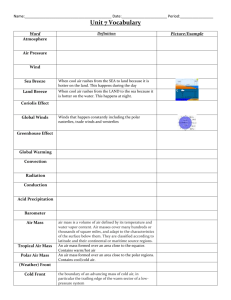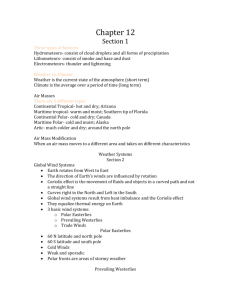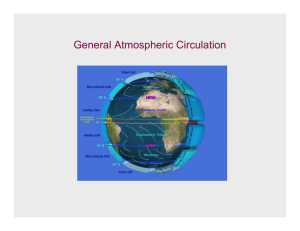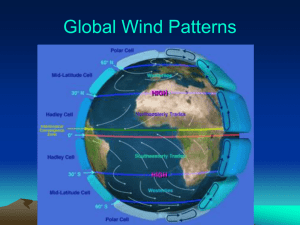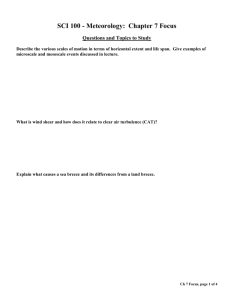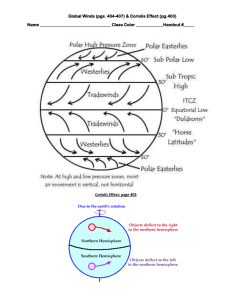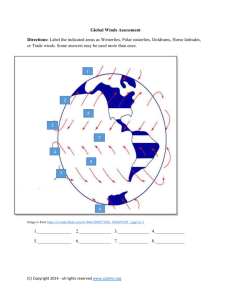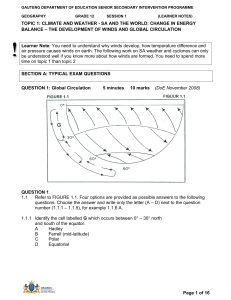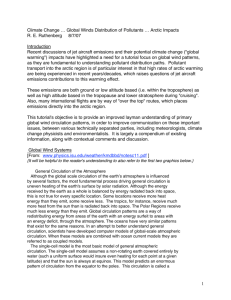Global wind circulation
advertisement
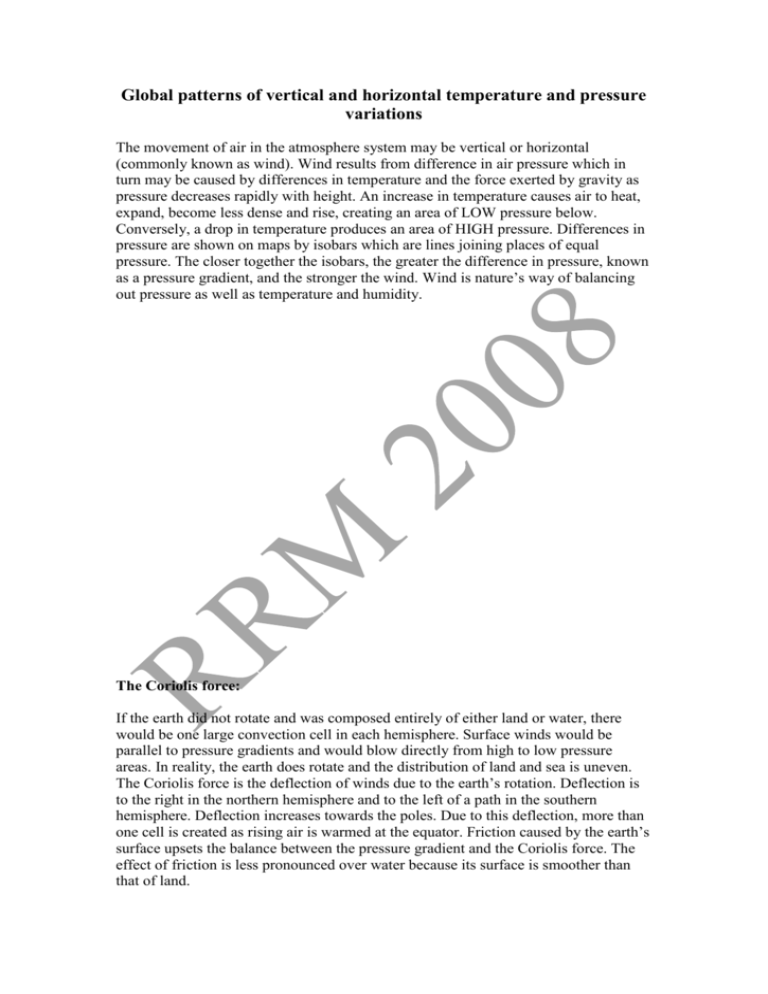
Global patterns of vertical and horizontal temperature and pressure variations The movement of air in the atmosphere system may be vertical or horizontal (commonly known as wind). Wind results from difference in air pressure which in turn may be caused by differences in temperature and the force exerted by gravity as pressure decreases rapidly with height. An increase in temperature causes air to heat, expand, become less dense and rise, creating an area of LOW pressure below. Conversely, a drop in temperature produces an area of HIGH pressure. Differences in pressure are shown on maps by isobars which are lines joining places of equal pressure. The closer together the isobars, the greater the difference in pressure, known as a pressure gradient, and the stronger the wind. Wind is nature’s way of balancing out pressure as well as temperature and humidity. The Coriolis force: If the earth did not rotate and was composed entirely of either land or water, there would be one large convection cell in each hemisphere. Surface winds would be parallel to pressure gradients and would blow directly from high to low pressure areas. In reality, the earth does rotate and the distribution of land and sea is uneven. The Coriolis force is the deflection of winds due to the earth’s rotation. Deflection is to the right in the northern hemisphere and to the left of a path in the southern hemisphere. Deflection increases towards the poles. Due to this deflection, more than one cell is created as rising air is warmed at the equator. Friction caused by the earth’s surface upsets the balance between the pressure gradient and the Coriolis force. The effect of friction is less pronounced over water because its surface is smoother than that of land. Global surface and upper wind circulation The major factor that causes atmospheric circulation is the unequal heating with latitude. Between 38 degrees south and 38 degrees north there is an excess of energy. Energy is transferred from low latitudes to high latitudes in order to balance this unequal heating. The global wind pattern is also known as the "general circulation" and the surface winds of each hemisphere are divided into three wind belts: Polar Easterlies: From 60-90 degrees latitude. Prevailing Westerlies: From 30-60 degrees latitude (aka Westerlies). Tropical Easterlies: From 0-30 degrees latitude (aka Trade Winds). The easterly trade winds of both hemispheres converge at an area near the equator called the "Intertropical Convergence Zone (ITCZ)", producing a narrow band of clouds and thunderstorms that encircle portions of the globe. 1. Tropical cell (Hadley cell) - Low latitude air movement toward the equator with heating, rises vertically, with pole ward movement in the upper atmosphere. This forms a convection cell that dominates tropical and sub-tropical climates. 2. Mid-latitude cell (Ferrel cell) - A mid-latitude mean atmospheric circulation cell for weather named by Ferrel in the 19th century. In this cell the air flows pole ward and eastward near the surface and equator-ward and westward at higher levels. 3. Polar cell - Air rises, diverges, and travels toward the poles. Once over the poles, the air sinks, forming the polar highs. At the surface air diverges outward from the polar highs. Surface winds in the polar cell are easterly (polar easterlies). This three cell model is effective for initial description, but it is still over simplified. However it provides a good starting point to describe the main features. Surface Features of the Global Atmospheric Circulation System Main wind belts: Because the Coriolis force act to the right of the flow (in the Northern Hemisphere), the flow around the 3-cells is deflected. This gives rise to the three main wind belts in each hemisphere at the surface: · The easterly trade winds in the tropics · The prevailing Westerlies · The polar easterlies Doldrums, ITCZ The doldrums are the region near the equator where the trade winds from each hemisphere meet. This is also where you find the inter-tropical convergence zone (ITCZ). It is characterized by hot, humid weather with light winds, major tropical rain forests found in this zone. Migrates north in January and south in July. Horse latitudes: The horse latitudes are the region between the trade winds and the prevailing Westerlies. In this region the winds are often light or calm, and were so-named because ships would often half to throw their horses overboard due to lack of feed and water. Polar front: The polar front lies between the polar easterlies and the prevailing Westerlies. Pressure belts: The three-cell circulation model would have associated with it the following pressure belts: · Equatorial low – A belt of low pressure associated with the rising air in the ITCZ. (The rising of warm air heated at the Equator causes an area of low pressure called Equatorial Low. As the air rises, creates clouds and precipitation.) · Subtropical high – A belt of high pressure associated with the sinking air of the horse latitudes. (At the subtropics the air cools and descends creating areas of high pressure with clear skies and little precipitation, called the Subtropical High. The descending air is warm and dry, and produces deserts in these regions.) · Sub polar low – A belt of low pressure associated with the polar front. · Polar high – A high pressure associated with the cold, dense air of the Polar Regions. As we have learned, the three-cell circulation model is an idealization, in reality, the winds are not steady, and the pressure belts are not continuous. There are three main reasons for this: · The surface of the earth is not uniform, or smooth. There is uneven heating due to land/water contrasts. · The wind flow itself can become unstable and generate “eddies.” · The sun doesn’t remain over the equator, but moves from 23.5N to 23.5S and back over the course of a year. Instead, there are semi-permanent high- and low-pressure systems. They are semipermanent because they vary in strength or position throughout the year.

